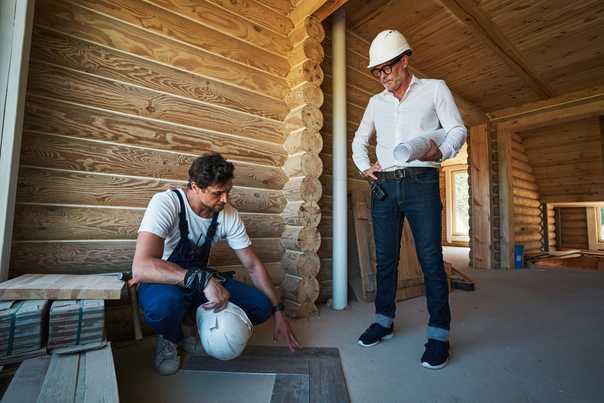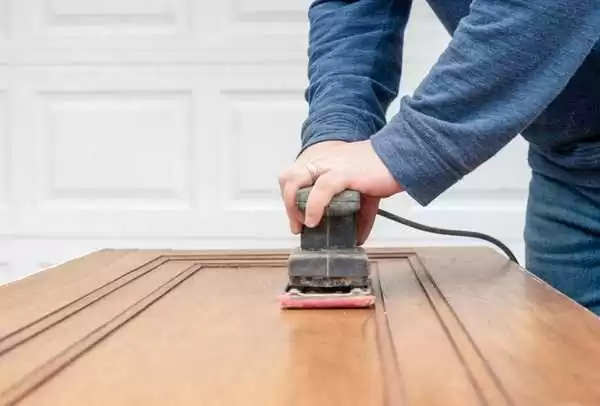Did you know that sanding hardwood floors by hand is possible? This article will help you understand how you can sand the hardwood floor with your hands and save time and money.
A lot of people think that sanding hardwood floors by hand is a time-consuming and useless process. But that’s not the case at all, especially if you choose the right sander for the job. To make things easier for you, here are steps to sanding hardwood floor by hand with the help of different sanders like a random orbital sander, palm sander, and belt sander, just to name a few:
Sanding hardwood floors by hand can be done with or without the use of sanders, depending on your preference and skill level. You might think that sanding your wood floor by hand would be too tedious, but with the right steps and the proper equipment, it will go much faster than you think. Below are the steps that will help you with how to sand hardwood floors by hands?
Key Takeaways


- Sanding hardwood floors by hand is a viable option if you choose the right sander for the job. It can save time and money, and many people prefer it for its potential fine finishing.
- Hand sanding is cheaper compared to using heavy-duty machines, making it an attractive option for DIY enthusiasts or those on a budget.
- Hand sanding offers more control, especially for reaching corners and edges that may be difficult to access with electric sanders. It allows users to learn more about their wooden floors and achieve better precision.
- Necessary equipment for hand sanding includes sanders (such as a random orbital sander), mask, vacuum cleaner, gloves, buckets, and safety goggles. Proper preparation is essential before beginning the sanding process.
- While hand sanding has advantages, it also has drawbacks. It requires more time and effort compared to using electric sanders, and the end result may not always be superior to machine sanding. Choosing the right sanding tool based on the project’s needs is crucial.
Why do people prefer sanding hardwood floors by hand even when heavy-duty machines are present?
In order to have a nice, smooth finish on your hardwood floors, you’ll need to choose between hand sanding and machine (or power) sanding.
Sanding hardwood floors by hand is cheaper
If you are looking for something that is inexpensive, doesn’t require lots of physical exertion or knowledge about woodworking, and can be done quickly, you should consider hand-sanding your hardwood floors.
Sanding floors by hand gives you more fine finishing
There are two main reasons people choose hand sanding over using machines: Aesthetics: Many homeowners choose hand sanding over power tools because they believe hand-sanding produces a more refined result.
This isn’t always true, but many experts agree that you will get better results using your hands than power tools when you need to buff out acceptable imperfections. The hand sander allows people to sand small areas without dragging around a large piece of equipment. Machine sanding does have its place
Hand sanding allows you to get into corners and edges that may be difficult to reach with an electric sander. You will also have more control over how much material is removed from your floor, as hand sanding gives you more precision than an electric sander.
Gives you chance to know more about your wooden floor
Hand-sanding is a great way to learn how much force is needed to remove surface scratches and dents. It also gives an insight into what kind of hand tool would work best in a particular situation and can be used as a general guide for when it’s better to use a machine.
People prefer hand sanding because they want to feel every inch of their wood floor. They want to see if any bumps or unevenness might require more attention before applying finish or stain.
Things you need for sanding the wood floor with hands
1) Sander
2) Mask
3) Vacuum cleaner
4) Gloves
5) Buckets and Cups
6) Safety Goggles
You get two pairs of goggles – one for you and another for your helper – since dust may fly when working on wood floors.
A step by step guide for how to sand wooden floors with a hand

Here we are talking about A step by step guide for how to sand wooden floors with a hand:
Step 1. Preparing
Preparing and Prepping Before you ever begin sanding, it’s essential to prepare your hands and workspace. Clean your work area and make sure you have plenty of rags on hand. Sandpaper is known for leaving tiny bits of paper everywhere, which can be a real pain when they end up stuck in everything you touch.
You should also wear gloves while working; while they won’t protect you from every injury, they will keep your hands safe from splinters and other minor accidents as you move around wood.
If you want to go above and beyond, wearing goggles or a face mask will keep dust out of your eyes and lungs.
Finally, don’t forget about ear protection! Sanding is loud enough without adding extra noise pollution into the mix. Make sure you wear hearing protection if you’re going to spend more than a few minutes doing any sort of sanding project. It doesn’t matter how careful you are, you can damage your ears over time because of exposure to excess noise.
Step 2. Lay down a drop cloth
Before you begin, make sure that you lay down a drop cloth. This will keep your work area free from dust and other particles that could stick to your freshly-sanded floors.
The drop cloth will also act as an additional safety precaution in case any scraped off wood particles get airborne. There’s nothing worse than breathing in wood dust when you’re trying to get some work done!
Step3. Fill up the bucket.
Now that you have your tools, fill up a bucket with water. You will be using it to dampen the area you are working on. This helps prevent dust from flying all over your home and also prevents splinters from forming in your hands while sanding. Once filled, set it aside and grab some paper towels or rags to use for cleaning up any messes you make during sanding.
Step 4. Get your tool ready
There are many types of sander used in today’s world. You can buy them online or from any hardware store near you. If you’re planning on hand-sanding, get a manual sander as it is inexpensive and easy to operate. You could also use electric tools like a drum sander which does an excellent job but cost more than your average DIY project.
Whatever tool you choose, make sure it has enough power to complete your work without slowing down halfway through. It will save you time and effort if you have all your materials ready before starting.
Step 5. Sand in a straight line
When you’re working with a hand sander, work in straight lines so that you can get a consistent result. To do so, place your hand on each side of the sander while you’re moving it along. You should be able to feel when you are going off course, which will make it easier for you to correct yourself before you have gone too far.
Be sure not to apply too much pressure when using a hand sander; instead, move lightly and let gravity do most of your work. If you find that one area is taking longer than another, stop and change direction or angle you may need to go over an area more than once if there are stubborn spots left behind from previous passes.
Step 6. Sand corner and edges
Turn your sander on its side, turn it up to speed 3, and begin smoothing your edge. Begin at one corner and move down both edges; then go back across from that corner. Repeat until you’ve covered all four corners and two sides. Then start in a new spot in another corner and repeat. This will ensure that you don’t miss any spots and you don’t over-sand any areas. Remember: slow is smooth, smooth is fast!
Step 7. The final step
Apply multiple layers of polyurethane. In total, we applied three coats and let each coat dry for about 12 hours before applying another one. This helps ensure a smooth, professional-looking finish on your project. After letting it cure for 48 hours, you’re ready to walk on it! But be careful to drop excess polyurethane; it will make the surface uneven and difficult to walk.
Polyurethane gives a durable finish that will stand up well under regular traffic. You don’t have to buy expensive finishes like marble or slate if you want natural-looking wood in your home—just apply polyurethane!
A disadvantage of sanding wooden floors by hands
- The biggest disadvantage of hand sanding hardwood floors is that it takes a lot longer than using an electric sander since it requires elbow grease and patience.
- In most cases, hand sanding won’t produce a superior result compared to power tools.
Some people prefer to sand wood floors with their hands by using machines like belt sanders, palm sanders, and other heavy-duty tools which are available to make wood floors smoother.
Different sanders that you can use to sand the hardwood floor
When choosing a sander, you need to pay attention to its power, speed, and weight. Since you’ll be using it only at home, it would be enough if it has adjustable speed control, not too high as can cause an accident and not too low for an effective result.
As for lightweight models, they are easier to handle but less powerful. Your hands must feel comfortable while holding it. The best way to check that is to try out several sanders in a store or ask someone who already owns one.
1. Orbital and random orbital sanders
There are many ways to do it, like using hands, and the methods depend on how hard the hardwood floor is. If you want a shiny finish, use an orbital sander for sanding the hardwood floor since it produces finer particles for an even smoother surface.
For an even result, we recommend getting rid of any gossamer imperfections when the sander is not in use before reusing it. Using random orbit sander to sand wood floors: most people choose random orbit over orbital as they can be used to sand almost anything.
They feature variable speed settings which allow users to control the amount of dust produced while working and reduce the risk of damage caused by overheating.
Advantages of using Orbital sanders
- An orbital sander is an electric power tool with a round pad connected to a disc or pad-like base. As it rotates, it agitates its surface, which helps make using them more manageable.
- Another advantage is that they can be used for both horizontal and vertical surfaces because their motion allows them to reach up high and into narrow spaces. This makes them ideal for sanding wood floors as well as other surfaces around your home.
- these are lightweight
- Another advantage is that they are lightweight, allowing you to hold and use them for longer periods without experiencing fatigue. This makes it easy for you to finish your project on time, regardless of its size.
The best orbital sander has many applications for wood floors that make it a worthwhile investment for any do-it-yourselfer.
Disadvantages of using orbital sanders
- Because of its small size, an orbital sander isn’t necessarily going to be able to reach into all of those nooks and crannies that you want.
- If you’re looking for a fast way to smooth your floors, you might not want to go with an orbital sander. However, if you have time on your hands, it can definitely do a great job smoothing out your floors.
2. Belt Sander for sanding floorboards by hands
This is probably what most people think of when they hear sander because it looks just like one. You simply run it back and forth across your wood until it’s smooth. These are great for getting rid of deep scratches or gouges that are too big for hand sanding.
Advantages
- Easy to handle as compared to heavy-duty machines
- Works at a reasonable speed, allowing you to manage the pressure according to the bumps present on the wooden floor.
Disadvantage
- It demands more hard work and patience as it takes longer than a usual heavy-duty sanding machine.
3. Festool Rotex sander

This sander can be the best choice to sand the wooden floor when sanding the detailed parts, such as the edges and stairs of your house’s wooden floor. It gives a smooth finish that enables you to walk comfortably barefoot on the wooden floor of your house.
You can also check out our other related article Sand Your Wood Floor:
Advantages
- The speed of this Festool Rotex is variable; you can control the speed according to your requirement.
- It gives you a smooth, highly comfortable finish, and the extractor is attached to it, which leaves no dust around.
Disadvantage
- As it’s not made for the sending of large wooden floors, it takes more time to sand a wooden floor than regular wood floor sanders.
FAQs
Here are some important FAQs:
Can I sand my wooden floor by myself?
Yes, you can sand your wooden floor by yourself. All you need is to know the details of the proper method, and you have to select the best hand sander to sand your wooden floor.
Which grit of sandpaper should I use to sand my wooden floor?
It depends on the type of your wooden floor or how long it’s been that you have sanded your house’s wooden floor. You can use 36 grit sandpaper if there is a thick layer of material to clean. If your wooden floor is painted, you can use 16 or 24-grit sandpaper. Floors like maple floors can be sanded by using 36-grit sandpaper.
How to clean the hard wooden floor after sanding?
Cleaning after sanding is an essential step for this purpose. First, brush the whole floor and then clean with the spirit. Cleaning with spirit will help you remove extra greasy stains if any.
Can I paint the wooden floor of my house right after sanding?
Yes, you can paint your wooden floor after sanding but make sure to clean the dust from your floor as it will interrupt your painting process, and even it can spread throughout your house, making it dirtier.
Can the dust that arises from sanding the wooden floor affect your health?
Yes, the dust produced during the sanding of wooden floors can cause many health problems. If this dust is inhaled, it can reduce the capacity of your lungs, which causes difficulty in breathing, and this difficulty in breathing causes the string in your heart which can result in several diseases. It is highly recommended to wear a mask and eye protection goggles before sanding the floor.
Final Remarks
Sanding the wooden floor is an ancient technique. Initially, the wooden floors were sanded with the help of hands, but later on, the invention of heavy-duty machines made the task quicker and easier. But still, some people think that sanding the wooden floor by hand is more reliable as compared to using heavy machinery as it allows you to go through the minor details and have the best possible results.
But sanding with hands is more effort-consuming and takes more time. But if you know the proper method of sanding the wooden floor by hand and know the sanding tool you should use. Then this task becomes more accessible and more convenient. Here is the stepwise guide to sanding the hard wooden floor and the detail of some best sanders to sand the wooden floor.

Why Trust About Sanders?
When it comes to the world of sanding and sanders, you need a trusted source of information and guidance to ensure you achieve those perfect finishes. That's where I come in – I'm Martin, a dedicated sanding enthusiast with a relentless passion for attaining flawless surfaces. With years of hands-on experience in the sanding industry, I've honed my skills and expertise to provide you with the most reliable and accurate insights. What sets me apart is my commitment to excellence. I meticulously handpick each sander after rigorous testing, ensuring that only the best tools make it to your hands. My goal is to empower you with the knowledge and recommendations you need to tackle any sanding task confidently. When you trust About Sanders, you're putting your faith in a seasoned expert who shares your passion for perfection and strives to deliver top-notch information and reviews for every sanding challenge.
